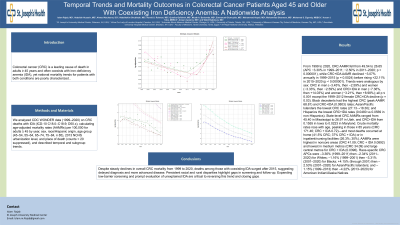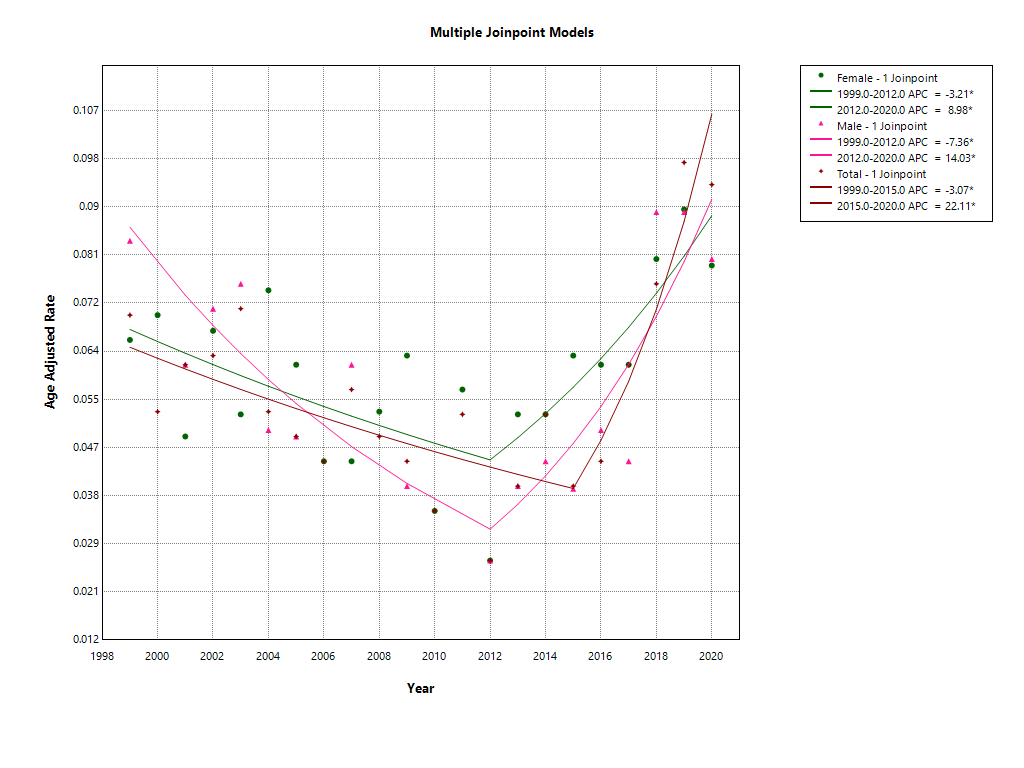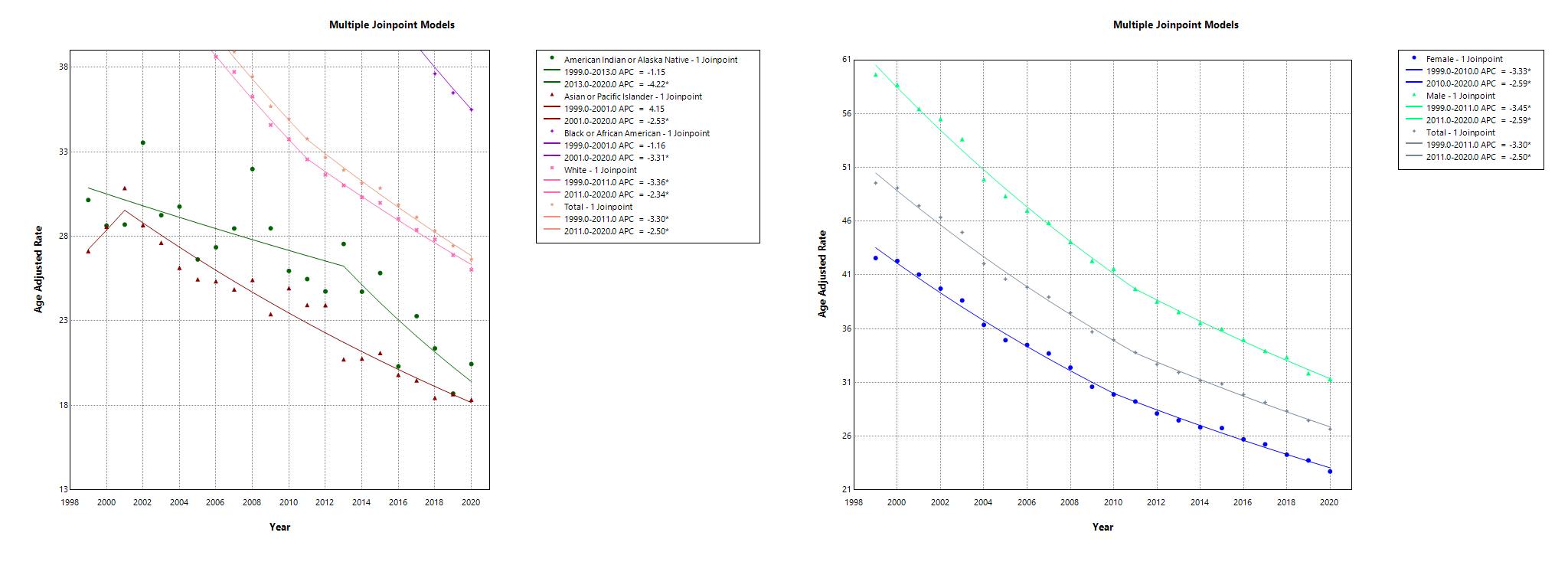Tuesday Poster Session
Category: Colon
P4585 - Temporal Trends and Mortality Outcomes in Colorectal Cancer Patients Aged 45 and Older With Coexisting Iron Deficiency Anemia: A Nationwide Analysis


Islam Rajab, MD
St. Joseph's University Medical Center
Paterson, NJ
Presenting Author(s)
1St. Joseph's University Medical Center, Paterson, NJ; 2Virtua Our Lady of Lourdes Hospital, Camden, NJ; 3Advocate Illinois Masonic Medical Center, Chicago, IL; 4University of Toledo, Toledo, OH; 5University of Missouri Kansas City School of Medicine, Kansas City, MO; 6Brookdale University Hospital Medical Center, New York, NY; 7Tanta University, Tanta, Al Gharbiyah, Egypt; 8An-Najah National University, Nablus, Palestinian Territories
Introduction:
Colorectal cancer (CRC) is a leading cause of death in adults ≥ 45 years and often coexists with iron‐deficiency anemia (IDA), yet national mortality trends for patients with both conditions are poorly characterized.
Methods:
We analyzed CDC WONDER data (1999–2020) on CRC deaths with IDA (ICD-10 C18.0–C18.9; D50.x), calculating age-adjusted mortality rates (AAMRs) per 100,000 for adults ≥ 45 by year, sex, race/Hispanic origin, age group (45–54, 55–64, 65–74, 75–84, ≥ 85), 2013 NCHS urbanization level, and place of death (counts < 20 suppressed), and described temporal and subgroup trends.
Results:
From 1999 to 2020, CRC AAMR fell from 49.54 to 26.65 (APC −3.30% in 1999–2011; −2.50% in 2011–2020; p < 0.000001), while CRC+IDA AAMR declined −3.07% annually in 1999–2015 (p = 0.0024) before rising +22.11% in 2015–2020 (p < 0.000001). Trends were analogous by sex: CRC in men (−3.45%, then −2.59%) and women (−3.33%, then −2.59%) and CRC+IDA in men (−7.36%, then +14.03%) and women (−3.21%, then +8.98%); all p ≤ 0.001 except the 1999–2012 female CRC+IDA decline (p = 0.03). Black decedents had the highest CRC (peak AAMR 68.81) and CRC+IDA (0.0803) rates; Asian/Pacific Islanders the lowest CRC rates (27.13→18.30); and Hispanics the lowest CRC+IDA rates (0.0480 vs 0.0569 in non‐Hispanics). State‐level CRC AAMRs ranged from 45.40 in Mississippi to 26.97 in Utah, and CRC+IDA from 0.1555 in Iowa to 0.0223 in Maryland. Crude mortality rates rose with age, peaking in those ≥ 85 years (CRC 171.46; CRC + IDA 0.72)—and most deaths occurred at home (41.5% CRC; 37% CRC + IDA) or in inpatient/nursing facilities (26.3%; 30%). AAMRs were highest in noncore areas (CRC 41.09; CRC + IDA 0.0892) and lowest in medium metros (CRC 34.09) and large central metros for CRC + IDA (0.0396). Race-specific CRC APCs were –3.36% (1999–2011) then –2.34% (2011–2020) for Whites; –1.16% (1999–2001) then –3.31% (2001–2020) for Blacks; +4.15% (through 2001) then –2.53% (2001–2020) for Asian/Pacific Islanders; and –1.15% (1999–2013) then –4.22% (2013–2020) for American Indian/Alaska Natives.
Discussion: Despite steady declines in overall CRC mortality from 1999 to 2020, deaths among those with coexisting IDA surged after 2015, suggesting delayed diagnosis and more advanced disease. Persistent racial and rural disparities highlight gaps in screening and follow-up. Expanding low-barrier screening and prompt evaluation of unexplained IDA are critical to reversing this trend and closing gaps.


Disclosures:
Islam Rajab, MD1, Abdallah Hussein, MD2, Ahmed Abuhasna, DO3, Abdalhakim Shubietah, MD3, Hamid U.. Rahman, MD3, Qutaiba Qafisheh, MD4, Muath A. Baniowda, MD5, Emmanuel Olumuyide, MD3, Mohammad Alqadi, MD4, Mohammad Ghannam, MD6, Mohamed S. Elgendy, MBBCh7, Hosam I. Taha, MBBCh7, Ameer Awashra, MD8, Walid Baddoura, MD1. P4585 - Temporal Trends and Mortality Outcomes in Colorectal Cancer Patients Aged 45 and Older With Coexisting Iron Deficiency Anemia: A Nationwide Analysis, ACG 2025 Annual Scientific Meeting Abstracts. Phoenix, AZ: American College of Gastroenterology.
